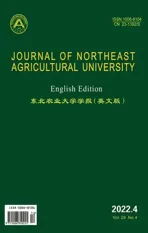Effects of Tillage Practices and Straw Management on Physical Properties of Mollisols,Root Architecture and Maize Yield in Northeast China
2022-02-05LiYuhangYangJiayuTangYuWangZihuaLiuYuzeHeWanYingCaoNingandGuSiyu
Li Yu-hang,Yang Jia-yu,Tang Yu,Wang Zi-hua,Liu Yu-ze,He Wan-Ying,Cao Ning,and Gu Si-yu
College of Resources and Environment,Northeast Agricultural University,Harbin 150030,China
Abstract:Tillage practices and organic amendment are strategies used worldwide to preserve the properties and fertility of soils.This study aimed to elucidate effects of 3-year field treatments of tillage practice and straw management on physical properties of Mollisols,root architecture and maize yield in northeast China.The experiment was conducted from 2015 to 2018 following a splitplot design of a randomized complete block with tillage practices [rotary tillage (R) and deep tillage (D)] as main plots and straw managements [straw returning (S),straw returning and organic fertilizer (M),straw removal (T)] as subplots.Soil samples at 0-15,15-30,30-50 cm depths and root samples at the seedling stage were collected.The results showed that DM treatment significantly improved soil moisture content at 10-50 cm soil depth and decreased soil compaction (P<0.05),which led to a better root architecture.Rotary tillage had a slower thermal conductivity but better thermal insulation performance,while deep tillage showed a higher daily temperature difference.Bulk density of topsoil was significantly lower in DS (1.16 g·cm-3) than in other treatments,but the soil permeability in DS (1.40 mm·min-1 in 0-15 soil depth and 1.45 mm·min-1 in 15-30 cm soil depth) was the highest.At the maize seedling stage,DM had the highest root dry weight,root-shoot ratio and root length,while RM had the highest root volume,root furcation number and root tip number.The maize yield of three years in DM was 6.19%,5.21% and 15.72% higher than that in DS,DT and RM (P<0.01),respectively.Relative to RT and DT,a slight decrease (2.72% and 0.93%,respectively) in maize yield under RS and DS was observed,which could be alleviated by the addition of organic fertilizer.The correlation matrix indicated that kernel per ear number and 100-kernel weight were the dominant factors that affected maize yield.Redundancy analysis suggested that straw managements and tillage practices were significantly positively correlated with root-shoot ratio,root dry weight,maximum root length,the total root length and maize yield,but significantly negatively correlated with soil compaction,bulk density,soil moisture content and soil temperature.Among all the treatments,deep tillage with straw returning and the addition of organic fertilizer was recommended as a promising strategy in restoring soil productivity,promoting maize growth and increasing maize yield in Mollisols of northeast China and similar regions around the world.
Key words:tillage,straw returning,organic fertilizer,soil temperature,soil moisture,soil compaction,redundancy analysis
Introduction
Tillage is a vital farming operation which influences soil properties and crop growth,especially soil physical properties and root architecture (Jabroet al.,2016;Bogunovicet al.,2018;Sunet al.,2018).Numerous studies have evaluated the effects of tillage practices on soil physical properties,root growth and crop yield.For instance,rotary tillage increases soil bulk density,but decreases saturated hydraulic conductivity (Sharmaet al.,2005),reduces soil thermal conductivity (Abu-Hamdeh,2000),and restrains root growth (Heet al.,2019).Zhanget al.(2018) found that 3-year rotary tillage increases soil compaction,but improves soil nutrient concentration in the topsoil.Some researchers found that deep tillage reduces soil strength and bulk density (Laddha and Totawat,1997),improves soil water storage and enhances root growth (Jiet al.,2013) by breaking the dense plough layer,increasing the total porosity and creating a favorable environment for the growth and development of root (Varsaet al.,1997;Sunet al.,2017).
As a comprehensive soil amendment method,straw returning and organic fertilizer addition play an important role in enhancing soil quality and have therefore attracted much attention of the agricultural community (Chanderet al.,1997;Liu,Yanet al.,2010).It is estimated that post-harvest crop straws amount to 5 million Mg worldwide every year(Cherubinet al.,2018).Traditionally,crop straws in many regions are directly burnt on the field,leading to a decline in the functional diversity of the soil (Guoet al.,2016).In contrast,the adoption of conservation tillage returns the crop straws into the field,which reduces soil compaction,increases soil porosity and water holding capacity (Hamza and Anderson,2005),and replenishes soil organic matter as well as improves soil fertility (Moyin-Jesu,2007;Chenet al.,2018).Straw returning with the addition of organic fertilizer has been reported to improve soil physical properties,enhance soil quality,better microorganism and nutrient condition (Watteauet al.,2012;Liuet al.,2010;Linet al.,2019),ultimately increase crop yield(Liu et al.,2019).Moreover,the combination of tillage practices,straw returning and organic fertilizer,which is considered as a comprehensive soil amendment method,plays a vital role in improving soil quality(Chenderet al.,1997).Awan (2009) demonstrated that deep tillage with straw returning significantly improves soil moisture content and reduces bulk density.Hanet al.(2020) found that deep tillage or rotary tillage with straw returning significantly increases crop yield and improves soil physicochemical properties.Mollisols of northeast China,characterized by unique forming condition and high nutrient concentration,as well as good structure,is crucial for food security and sound agricultural ecological environment (Yinet al.,2015).Nevertheless,given the soil degradation such as soil fertility decline,acidification,physical and chemical properties degradation caused by intensive fertilizer and agrochemicals application,a series of conservation projects have been implemented in this region (Liuet al.,2010).Generally,rotary and deep tillage are practiced by local farmers and landowners.In this area,deep tillage improves soil nutrient condition(Heet al.,2020),while rotary tillage increases soil bulk density and compaction as well as restrains maize root growth (Youet al.,2017).Menget al.(2016) revealed that deep tillage with organic fertilizer application improves soil structural properties,especially decreases bulk density.Zhanget al.(2018) indicated that straw returning increases soil organic matter and microbial richness.To the best of our knowledge,there is no thorough comparison between the effects of the two tillage practices and straw management on soil physical properties and root architecture,as well as maize yield in Mollisols of northeast China.Therefore,related study still requires further investigation.The aims of this work were to study the effects of tillage practices and straw managements on soil physical properties and root architecture,as well as crop yield in Mollisols of northeast China,which would provide an insight for the maintenance and restoration of Mollisols fertility in this area.
Materials and Methods
Experiment site and soil
This research was carried out in Shuangcheng District,Harbin City,Heilongjiang Province,China (45°45′N,126°55′E).The area has a temperate continental monsoon climate with long-term (30-year) average annual precipitation of 481 mm and annual temperature of 4.4℃,and 60% of the rainfalls occurs in the summer (June to August),and the average altitude is 200 m.The soil in this region is classified as typical Mollisols based on the USDA soil taxonomy.Before treatments,rotary tillage and conventional fertilizer management had long been used in the area.The soil physical and chemical characteristics at 0-30 cm soil depth were as follows: soil moisture content of 10.81%,soil compaction of 893.6 kPa,soil bulk density of 1.32 g · cm-3,soil permeability of 1.14 mm · min-1,pH of 5.74,soil organic carbon of 34.96 g · kg-1,the total N of 1.81 g · kg-1,the total P of 0.56 g · kg-1,available N of 70 mg · kg-1,available P of 33.5 mg · kg-1,and available K of 158 mg · kg-1.
Experiment design
Field treatment was initiated in the autumn of 2015 and ended in autumn 2018,following a spilt-plot design of a randomized complete block and with tillage practices (R,rotary tillage;D,deep tillage) as main plots and straw managements (S,straw returning;M,straw returning and organic fertilizer;T,straw removal) as subplots.The experiment comprised six treatments,namely,RT,RS,RM,DT,DS and DM.Each treatment was arranged with three replicates.Details of experiment design are shown in Table 1.Maize (var.Hongshuo 616) was sowed in early May at a planting density of 45 000 plants · hm2and harvested in the middle of October.Fuduobao compound fertilizer (N-P2O5-K2O=26-12-14) and organic fertilizer was applied at a rate of 450 kg · hm-2and 15 t · hm-2,respectively.After sowing,broad-spectrum herbicide atrazine was used.Topdressing using urea fertilizer(46%) at a rate of 150 kg · hm-2was applied at the end of June.The maize was harvested at the end of September.

Table 1 Details of experiment design
Parameters and measurement methods
The air temperature was collected according to the daily local weather forecast.The soil temperature was measured using an apparatus invented by Guet al.(2017),which realized the multi-point and real-time acquisition of soil temperature with high degree of automation,high monitoring accuracy and reliable results.The Pt 100 thermal resistance soil temperature sensor was buried at soil depths of 10,20 and 30 cm to monitor the field soil temperature dynamics remotely at 1 min interval.
The soil moisture contents at 0-10,10-20,20-30,30-50,50-70,70-90 and 90-120 cm depths during the growth stage of maize were determined by TDR(TRIME-PICO-IPH,Germany) anchored in RT,RS,RM,DT,DS and DM.
The SC900 (SPECTRUM SC-900,America) was used to determine the soil compaction at 0-45 cm soil depth at the seedling stage,elongation stage and harvest stage,respectively.Nine replicates were implemented at each plot.Soil bulk density at 0-15 cm and 15-30 cm soil depths was measured using cutting ring method.Soil permeability was determined according to the Darcy's Law:
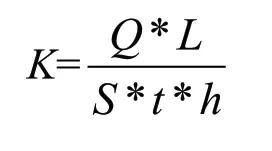
Where,Kwas the coefficient of permeability;Qwas the flow rate;Lwas penetration distance;Swas the cross-sectional area of penetration tube;twas time;andhwas the water layer thickness.
Twelve maize samples collected from every plot at the seedling stage were taken back to the laboratory instantly,then plants were separated into aboveground and underground.The roots were washed with distilled water for the measurement of root architecture.Root architecture parameters were measured using a root analysis instrument (WinRHIZO;Regent Instruments Inc.,Quebec,ON,Canada),according to the method described by Xu and Shi (2007).Finally,the roots were dried to measure the root dry weight (RDW),and root-shoot ratio (R/S) was calculated.
Thirty maize ears in each plot were randomly sampled for the determination of maize yield and yield component: ear length,ear diameter,kernel row number,per row kernel number,kernel per ear number and 100-kernel weight.Then the maize yield was calculated.
Data analysis
Data were statistically analyzed using the SPSS22.0 program.Duncan test and analysis of variance(ANOVA) were used to test the significance of the effects of tillage and straw managements on soil physical properties,root architecture and maize yield.The correlation of yield and yield components was based on Pearson correlation coefficient.Canoco5 was used to plot RDA (redundancy analysis) diagrams.R version 3.3.2 and Origin 2018 were used to draw the figures.
Results
Soil physical properties
In total,483 840 soil temperature values were obtained,and 24 364 values were screened out with the soil temperature on precise hour representing average soil temperature per hour.The consecutive variations of soil temperature per hour at the seedling stage,elongation stage and harvest stage are presented in Fig.1.It indicated clearly that the variation of soil temperature at 10 cm soil depth was slighter than that at 30 cm soil depth and deep tillage displayed a more dramatic soil temperature change.At the seedling stage,soil temperature at 6:00 a.m.reached its valley and peak at around 3:00 p.m.At the elongation stage,the soil temperature was the highest at 10 cm soil depth and the lowest at 30 cm soil depth.There was no significant difference was observed in different treatments,all the treatments reached their valleys and peaks at the same time.At 10 cm soil depth,the maximum temperature of the D treatment was 0.2℃ lower than that of the R treatment.At the depths of 20 and 30 cm,the maximum temperatures of the D treatment were 25.0℃ and 22.5℃,respectively,which were 0.8℃ and 0.9℃ higher than those of the R treatment.At the harvest stage,soil temperature at different soil depths was the highest at 30 cm and the lowest at 10 cm.At 10 cm soil depth,the soil temperature of the D treatment reached its peak at 4:00 p.m.,1 h earlier than that of the R treatment,but the maximum temperature decreased by 0.4℃.The maximum temperatures at the depths of 20 and 30 cm appeared at the same time under different treatments with the D treatment 1.3℃ and 1.6℃higher than R treatment.Therefore,rotary tillage had a slower thermal conductivity but better thermal insulation performance with longer time taken for heat to be transferred from the surface to the deep soil.Deep tillage had a more considerable daily temperature difference due to higher thermal conductivity.
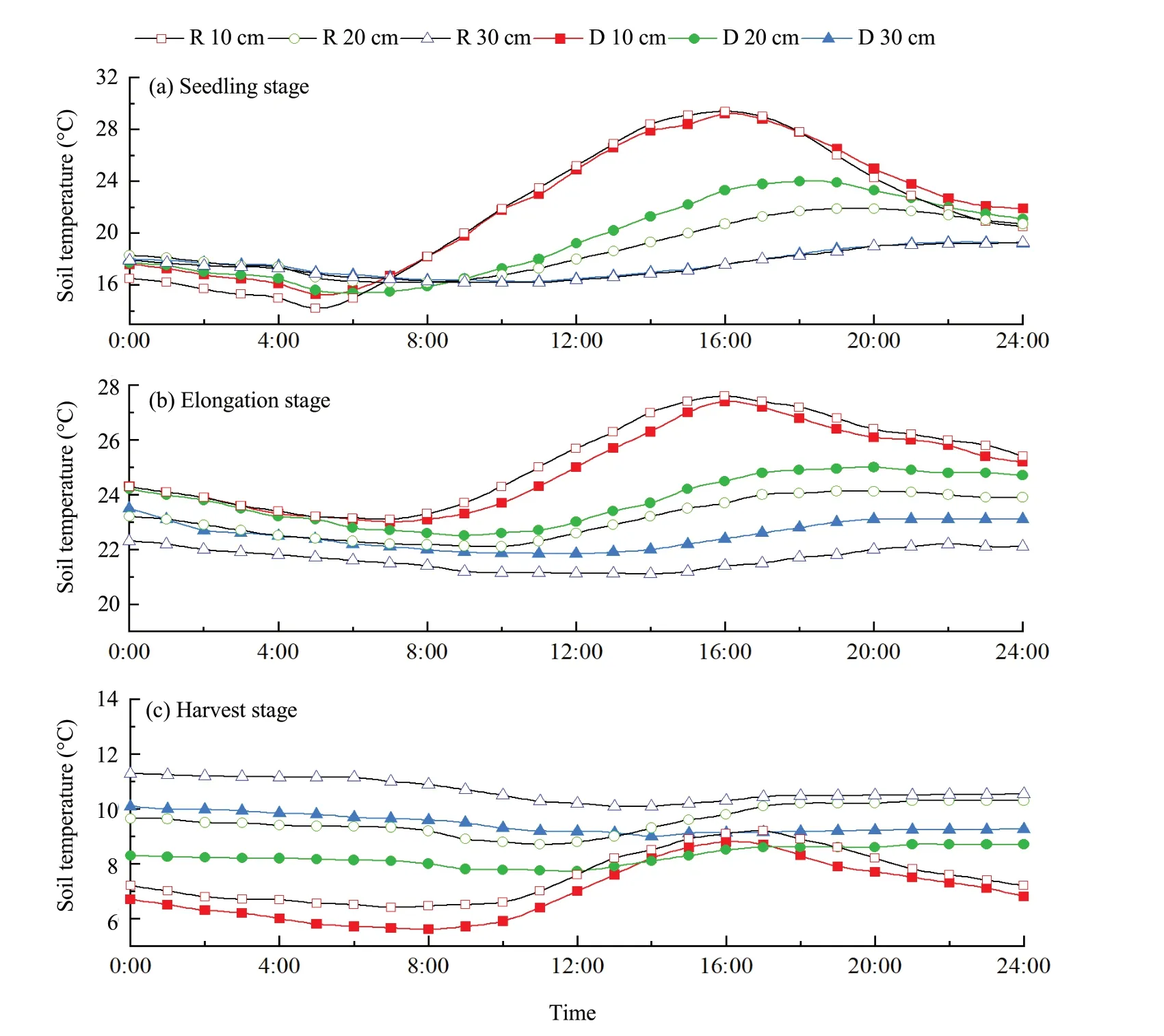
Fig.1 Continuous variations of soil and air temperature per hour at seedling stage (June 5th,2018),elongation stage (July 1st,2018) and harvest stage (October 6th,2018) under different treatments
The variations of soil moisture contents at the three stages of maize,namely the seedling stage,elongation stage and harvest stage,respectively,are presented in Table 2.It appeared that the soil moisture contents in various treatments increased by soil depth increments.In the case of insufficient rainfall at the seedling stage,the soil moisture contents of 0-50 cm soil depth in DT,DS and DM were significantly 25.93%,16.51% and 27.69%higher than those in RT,RS and RM,respectively.Straw returning and organic fertilizer both enhanced soil moisture contents in varying degrees.Under the condition of sufficient rainfall at the elongation stage,the soil moisture contents of RT and DT were significantly increased as compared to the seedling stage.At 0-50 cm soil depth,the soil moisture contents were considerably improved in DS,DM,RS and RM.During the harvest stage,the soil moisture decreased modestly and the distribution was similar to the elongation stage.

Table 2 Changes of soil moisture contents at seedling stage (June 5th,2018),elongation stage (July 1st,2018) and harvest stage(October 6th,2018) under different treatments
For the variation of soil compaction at different stages of maize growth,it appeared that the soil compaction apparently increased by soil depth increments,and rotary increased the most (Fig.2).In general,soil compaction under rotary tillage first increased and then decreased with the advance of maize growth,while deep tillage showed an increasing trend.At the seedling stage,as compared to RT,RS and RM,the soil compaction in DT,DS and DM significantly decreased by 4.36%,10.17% and 9.88% at 0-45 cm soil depth (P<0.01),respectively.Additionally,straw returning increased soil compaction in various treatments,with an increase range of 2.67%-3.62%,which could be alleviated by the addition of organic fertilizer.

Fig.2 Heat map for variation of soil compaction at seedling stage (June 5th,2018),elongation stage (July 1st,2018) and harvest stage (October 6th,2018) of maize by depth increments under different treatments
In general,the soil bulk densities among different treatments were significantly different (Fig.3a).Rotary tillage presented a higher bulk density at depth of 15-30 cm compared with that of 0-15 cm.Contrary to RS,DS significantly decreased bulk density by 8.60% as compared to DT.Regarding the soil permeability (Fig.3b),generally,it presented that deep tillage was higher than that of rotary tillage and straw returning increased the permeability.Furthermore,relative to all the treatments,the soil permeability was improved to different degrees by straw returning,and in RS and DS it was significantly 7.16% and 14.28% higher than that in RT and DT,respectively.

Fig.3 Soil bulk density (BD) and permeability at harvest stage (October 6th,2018) of maize under different treatments
Root architecture and maize yield
As shown in Fig.4a,the root dry weight in DM was significantly higher than that in other treatments.The root diameter,root total length and maximum root length were not significantly different among all the treatments (Fig.4b,d,e).Deep tillage had the highest root-shoot ratio,and in DM it was significantly 89.34% and 127.69% higher than that in DT and RM,respectively (Fig.4c).Regarding the root surface area in different treatments,it turned out that rotary tillage had the highest value (Fig.5f).The root volume in RT was significantly 9.52% lower than that in RM,but 27.98% higher than that in RS (Fig.4g).RM had the highest root furcation number and root tip number,which were decreased in RS (Fig.4h,i).Furthermore,the two-way analysis of variance indicated that tillage practices had significant effects on root length,rootshoot ratio,root surface area,root volume,root furcation number and root tip number,while straw managements and their interaction had no significant effects on root architecture except root volume.

Fig.4 Root dry weight (RDW),root diameter (RD),root-shoot ratio (R/S),total root length (TRL),maximum root length(MRL),root surface area (RSA),root volume (RV),root furcation number (RFN) and root tip number (RTN) at harvest stage (October 6th,2018) under different treatments
In order to better understand the effects of different tillage practices on the maize yield,it was useful to decompose yield into measurable yield components(Kambal,1969).As shown in Fig.5a,d,e,regarding the ear length,per row kernel number and kernel row number,no difference was observed among different treatments.DT had the highest ear diameter and kernel per ear number (Fig.5b,c).The 100-kernel weight in deep tillage was significantly 6.89% higher than that in no-tillage (Fig.5f).Regarding the maize yield of the three years (Fig.5g,h,i),in 2016,the maize yield was considerably higher in DT,with a mean of 12.15 t·hm-2.In 2017,DM significantly increased maize yield by 7.45% and 13.22% compared with DT and RM,respectively.In 2018,maize yield in DM was significantly higher than that in other treatments.Additionally,maize yield in RS was lower than that in other treatments in the three years.Furthermore,twoway analysis of variance indicated that the effects of tillage practices and straw managements on kernel per ear number,100-kernel weight and maize yield were significant,and the effects of their interactions on maize yield were also significant.
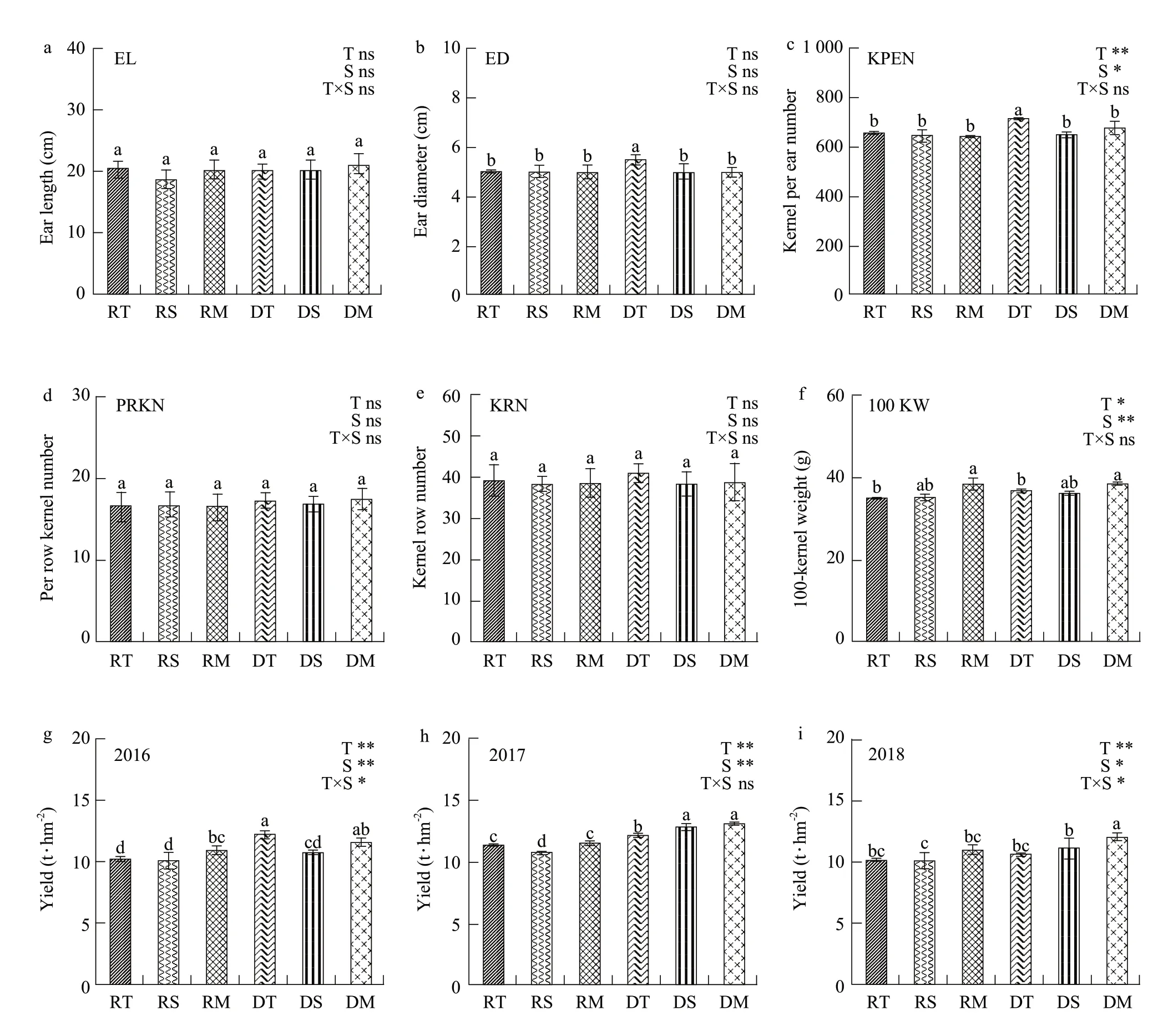
Fig.5 Ear length (EL),ear diameter (EL),kernel per ear number (KPEN),per row kertel number (PRKN),kernel row number (KRN) and 100-kernel weight (100 KW) at harvest stage (October 6th,2018) and maize yield of three years under different treatments
The scatter matrix of maize yield and crop yield components is shown in Fig.6.It indicated that the maize yield had a significant positive correlation with the 100-kernel weight and kernel per ear number (P<0.01),and showed the highest correlation with kernel per ear number (KPEN) (r=0.816),followed by 100-kernel weight (100 KW) (r=0.526).In addition,deep tillage decreased the correlation of yield with the total root length (TRL) (r=-0.692),100 KW (r=-0.046) and root furcation number (RFN)(r=-0.564),but significantly increased the correlation of yield with KPEN.
Relationship of soil physical properties,root architecture and yield
Redundancy analysis was used to analyze the correlation among root architecture,maize yield and environment factors (Fig.7).Root architecture and maize yield correlated significantly with environment factors (P=0.002).The first,second and third axes explained 67.97% of the variation (51.23% for the first axis,13.98% for the second axis and 1.73% for the third axis).Straw managements and tillage practices were positively correlated with root-shoot ratio,root dry weight,maximum root length,the total root length and maize yield,while soil compaction,bulk density,soil moisture content and soil temperature had significant but negative correlation with them.
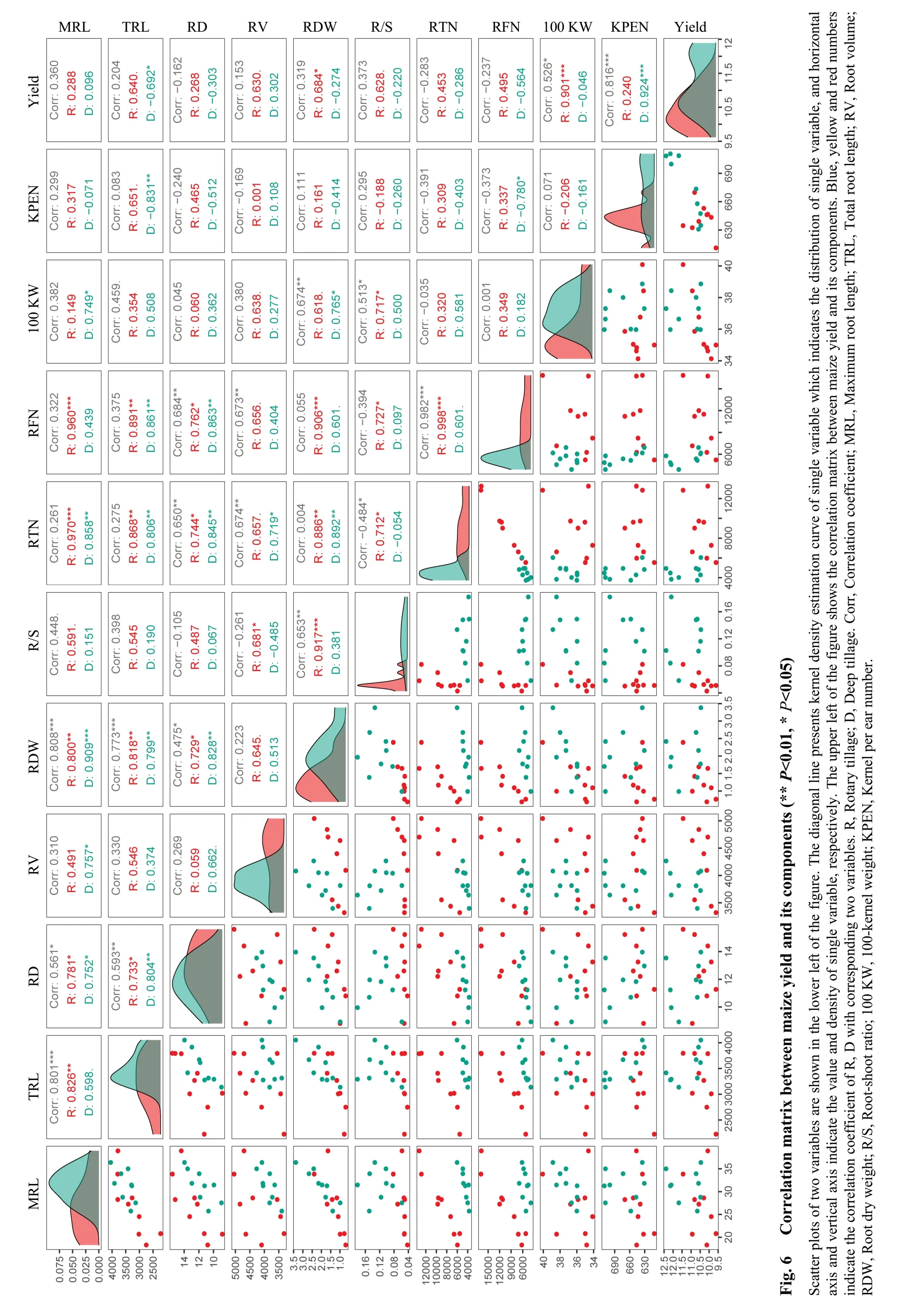
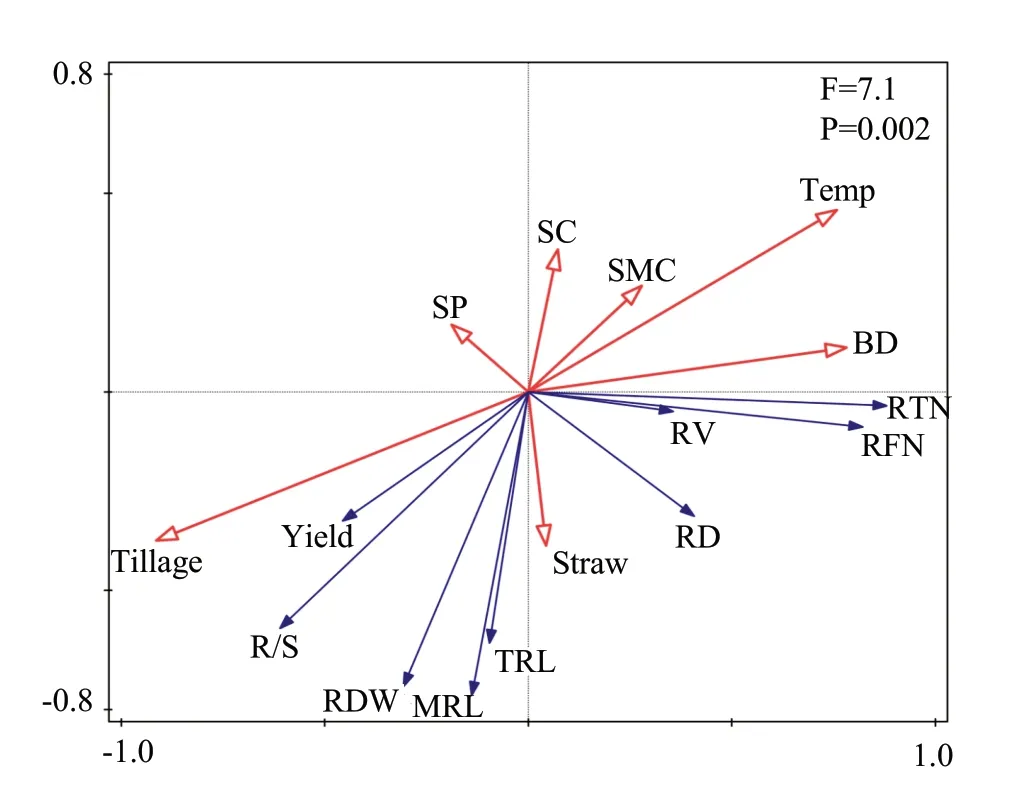
Fig.7 RDA (redundancy analysis) identifying relation among maize yield,root architecture and environment factors (tillage practices,straw managements and soil physical properties)
Discussion
Effects of tillage practices and straw managements on soil physical properties
Tillage practices could affect soil physical properties by changing the structure of the topsoil (Ball,2013;Franco-Luesmaet al.,2020).The present study found that deep tillage increased soil permeability,while decreased soil bulk density and moisture content,which was also demonstrated by Jabroet al(2016).Straw returning with the addition of organic fertilizer in deep tillage presented a noticeable decrease in soil compaction,which could enhance the extension of the root system and the infiltration of rainwater (Kounoet al.,1992).This study found that deep tillage had a wider daily soil temperature difference,but decreased soil temperature compared with rotary tillage.This might be attributed to the experimental site being situated in high latitudes where the daily temperature in autumn rapidly fell.Additionally,tillage mainly affected the temperature on topsoil (0-10 cm),which agreed with Xuet al(2017).In the spring of 2018,a drought occurred,soil porosity increased and water evaporation under deep tillage was strong (Wanget al.,2015),which resulted in a decrease of soil moisture content,thus affecting the thermal conductivity and heat capacity of soil (Al-Kayssiet al.,1990).In summer,sufficient rainfalls improved the soil moisture content,particularly in deep tillage,which indirectly resulted in the decrease of soil temperature,and in turn,low soil temperature reduced water evaporation and improved the rainwater use efficiency.
Previous study indicated that maize straw returning to the field increased soil moisture content (Yanget al.,2020),which was consistent with this study.The soil moisture content increased in deep tillage with straw returning for the reason that straw mulching reduced the exposure of soil to the sunlight and prevented the evaporation of soil water.Liuet al.(2019) found that the straw layer could provide an accommodation for water,which improved the water retention,and Houet al.(2019) also found that straw returning improved the water use efficiency.In the current study,straw returning significantly reduced soil compaction,which agreed with the previous report(Shuet al.,2014).However,the soil compaction under straw returning with organic fertilizer was increased modestly at the harvest stage,this might be attributed to the fact that the application of organic fertilizer significantly improved the root architecture (Heet al.,2020),and in turn increased the soil compaction.
Effects of tillage practices and straw managements on root architecture and crop yield
The performance of soil physical properties,which correlated to the absorption of moisture and nutrients by roots,was crucial to the growth and development of crops (Liet al.,2015).Soil physical changes that occurred under different tillage practices could affect the growth of the main root axes,particularly at the early stages of crop growth (Lampurlanés and Cantero-Martínez,2003).Many studies had indicated that preferable soil environment was vital to the biomass and growth of root.For instance,severe soil compaction level could constrain the extension of root in soil,decrease the absorption and further affect the transportation of water and nutrient,and consequently result in a decrease of crop yield (Fageria and Moreira,2011;Grzesiaket al.,2012;Nuneset al.,2019).The present study showed that the root architecture and maize yield under rotary tillage with straw removal were the worst among all the treatments.Some plausible reasons for this observation might be that mechanized sowing and harvesting increased soil compaction of rotary tillage (Reichertet al.,2009),decreased soil permeability (Suzukiet al.,2013),and hindered water transportation (Nuneset al.,2015),thus resulting in low seedling emergence and long growth cycle,further leading to poor root architecture as well as a low maize yield.Compared with straw removal,straw returning under rotary tillage improved the phenomenon aforementioned.Redundancy analysis indicated that maize yield and root architecture were positively correlated with tillage practices,and soil compaction was the dominant factor affecting crop yield,which was also confirmed by Nuneset al(2015).According to scatter matrix and redundancy analyses,it also indicated that maize yield was mainly affected by root length,root dry weight,root volume,100-kernel weight and kernel per ear number,and in deep tillage,the effects turned out to be stronger,which was also confirmed by Kaur and Arora (2019).In this experiment,root furcation number and root tip number under rotary tillage were higher than those in deep tillage,which indicated that a lateral extension of root existed in this treatment.Additionally,the disturbance on the soil under deep tillage decreased soil compaction,but increased the infiltration of water,which enhanced root growth and resulted in a higher root length,root-shoot ratio,root dry weight,root volume and maize yield.
In a global context,straw returning to the field played an important role in improving soil productivity,crop growth and crop yield (Miuraet al.,2015;Yagiokaet al.,2015).The combination of straw returning and organic fertilizer could increase soil organic carbon and enhance nutrient absorption by root (Liet al.,2018;Muhammadet al.,2020).Previous study (Yanet al.,2020) demonstrated that maize straw returning to the field in the drought year could prevent yield loss caused by water stress.Conversely,the results showed that straw returning did not lead to greater maize yield.This might be attributed to the conjecture that short-term straw returning had limited effects on the absorption of moisture.However,the combination of straw returning with organic fertilizer under each treatment increased maize yield in this study,which was consistent with the previous finding (Muhammadet al.,2020).Root length,root-shoot ratio,root dry weight and 100-kernel weight were also enhanced,which made contribution to the maize yield.Thus,it was suggested that the establishment of tillage practices and straw returning could improve maize root architecture,further enhance maize growth and increase maize yield.
Conclusions
The study extended the previous findings on the changes in soil physical properties,root architecture and maize yield under different tillage practices and straw management of Mollisols.Deep tillage,particularly DM,significantly increased soil moisture content at 10-50 cm soil depth,but decreased soil compaction,which led to a better root architecture.Rotary tillage had a slower thermal conductivity but better thermal insulation performance,while a higher daily temperature difference was observed in deep tillage.Bulk density of topsoil was significantly lower in DS than that in other treatments,while the soil permeability in DS was the highest.Compared to straw removal and straw returning,straw returning with the addition of organic fertilizer under the two tillage treatments improved soil moisture content and loosened plow layer.In general,deep tillage had better root architecture than that in rotary tillage.KPEN and 100 KW were significantly and positively correlated with the maize yield.DM led to a higher 100 KW and maize yield than that in other treatments.Compared to straw removal,a slight decrease in maize yield occurred under treatments with straw returning,which could be alleviated by the addition of organic fertilizer.Straw managements and tillage practices were positively correlated with root-shoot ratio,root dry weight,maximum root length,the total root length and maize yield,while soil compaction,bulk density,soil moisture content and soil temperature had significant but negative correlation with them.It could be concluded that straw returning with the addition of organic fertilizer under deep tillage had the potential to improve soil physical properties,promote maize growth,and increase maize yield in Mollisols of northeast China and similar regions around the world.
杂志排行
Journal of Northeast Agricultural University(English Edition)的其它文章
- Journal of Northeast Agricultural University (English Edition)Instruction to Authors
- Total Contents of Volume 29(2022)
- Research Progress of Vitamins on Muscle Regeneration
- Real-time Prediction Model of Amount of Manure in Winter Pig Pen Based on Backpropagation Neural Network
- Investigation and Analysis of Grassland Plant Germplasm in Zhalantun City of Eastern Inner Mongolia
- Regulation of Migration,Phagocytosis and Apoptosis of Human Neutrophils by Recombinant Human Intestinal Alkaline Phosphatase
